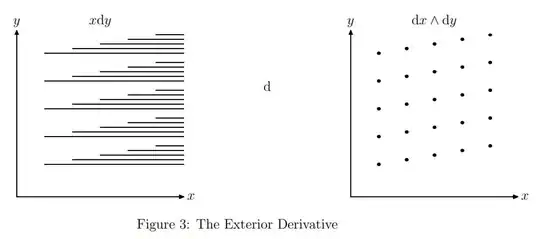This paper provides a geometric intuition of differential forms. On page $5$ it reads:
"Consider the case $xdy$. The number of horizontal lines is roughly proportional to $y$. In other words the number of lines that 'come to an end' in any area is roughly the same wherever we look. This is just like the example $dx ∧ dy$ above. You may have guessed what is going on here: $d(xdy) = dx∧dy$. In other words exterior derivative is none other than finding the boundary of the picture."
Why can the exterior derivative of a form $\omega$, defined as
$$d\omega = d\left(\sum_{i_1,\ldots,i_k}\omega_{i_1,\ldots,i_k}dx^{i_1}\wedge\ldots\wedge dx^{i_k}\right)\\ \ \ = \sum_{i_1,\ldots,i_k}d\omega_{i_1,\ldots,i_k}\wedge dx^{i_1}\wedge\ldots\wedge dx^{i_k}\\ \ \ \ \ \ \ \ \ \ \ \ \ \ \ \ \ \ \ \ \ \ \ = \sum_{i_1,\ldots,i_k}\sum_{\alpha=1}^nD_{\alpha}(\omega_{i_1,\ldots,i_k})\ dx^{\alpha}\wedge dx^{i_1}\wedge\ldots\wedge dx^{i_k}\\ $$
be interpreted as the quantity of points at which the lines in the picture come to an end?
